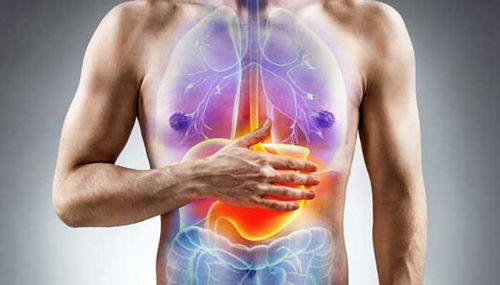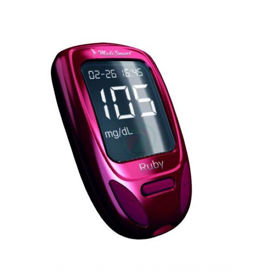Diabetes, the most common disorder of the endocrine system, affects 50,000 to 100,000 people in Slovenia. The disease occurs due to a disturbance in the blood's insulin level. Insulin is a pancreatic hormone that helps the body convert blood glucose, or blood sugar, into energy.
DIABETES DISEASE: General | Symptoms | Hidden dangers | Causes | First aid | Diagnostic Procedures | Treatment | Foot Care | Prevention | Questions and Answers | Sources/references
Type I diabetes - sometimes called insulin-dependent diabetes, juvenile diabetes, or diabetes with onset in childhood - results from a lack of insulin.
Type II diabetes - sometimes called non-insulin-dependent diabetes, adult-onset diabetes, or stable diabetes - results from the body's inability to process the hormone effectively. About 90% of all people with diabetes have this type of disease.
Image: Complications from diabetes are among the leading causes of blindness in adults.
.jpeg)
No matter what type of diabetes you have, you should work closely with your doctor for proper diet, medication, and daily physical activity. Your ability to take care of yourself significantly impacts whether you can control the condition and avoid the potentially severe effects of this disease. Many complications that may appear early or later require as much care as the disease. The most important thing is to monitor your blood sugar levels daily to prevent hypoglycemia attacks, in which your blood sugar level is too low to meet your body's energy needs.
Hyperglycemia, or high blood sugar, can trigger a severe diabetes condition called ketoacidosis. In ketoacidosis, the blood becomes increasingly acidic (acidotic) because toxic byproducts called ketones accumulate. Ketones are produced when the body breaks down fat for energy. Ketoacidosis occurs in patients with type I diabetes when they do not receive an adequate supplemental insulin dose, and their body is therefore deprived of an energy source. Ketoacidosis can also occur in patients with diabetes if the glucose and insulin level in the blood is not balanced or if the body is under stress due to an accident or illness.
Video content: Sladkorčki, a Slovenian documentary film about type 1 diabetes.

If you have diabetes, pay particular attention to the warning signs of ketoacidosis: nausea, excessive thirst, frequent urination, severe weakness, abdominal pain, and rapid and deep breathing. If you do not respond immediately and receive insulin and intravenous saline solutions (to replace lost body fluids), you may fall into a coma or even die.
Late complications of diabetes can damage the eyes, nervous system, kidneys, cardiovascular system, and circulation and reduce the body's general resistance to infections. People with diabetes have slower healing of wounds and ulcers. They are also more susceptible to gum problems, urinary tract infections, and mouth infections such as thrush caused by an overgrowth of fungal organisms.
Complications from diabetes are among the leading causes of blindness in adults. About ten years after diabetes is diagnosed, half of people with diabetes develop an eye disorder called diabetic retinopathy, in which the capillaries that supply blood to the retina or retina of the eye weaken, eventually leading to walking. Sight. Almost everyone who has had diabetes for 30 years develops some degree of diabetic retinopathy. Cataracts and glaucoma also occur more often in patients with diabetes.
People with diabetes are also more likely to develop heart disease and circulatory diseases such as high blood pressure, calcification of the arteries, heart attack, and stroke. Poor blood circulation in diabetic patients also makes them more susceptible to skin ulcers, cramping, and gangrenous (tissue-destroying) infections. Damage to blood vessels in the kidneys can lead to kidney failure.
Many people with diabetes suffer from diabetic neuropathy, which causes the gradual collapse of the nervous system. The condition appears to occur relatively early in both types of diabetes and affects both motor and sensory nerves. Because of this, people with diabetes often experience various tears and pains. Some also experience weak reflexes, loss of sensation, paralysis and tingling in the legs, impotence, and circulatory disorders.
Symptoms
Symptoms include:
- increased thirst and running
- more frequent urination (sometimes even every hour)
- weight loss
- fatigue
- nausea, including vomiting
- unsharp vision
- in women, frequent vaginal infections and possibly even absence of menstruation
- impotence in men
- fungal infections in women and men
Consult your doctor if:
- You feel sick, tired, and excessively thirsty; you urinate more often; you have abdominal pain; you breathe deeper and faster than usual; and you may have a sweet breath that resembles the smell of nail polish remover. You may need immediate medical attention for ketoacidosis.
- You are tired or feel like you will pass out; your heart beats faster; you shake and sweat excessively; you are irritable, hungry, or suddenly sleepy. You may have hypoglycemia, so you need to eat or sleep quickly to avoid more severe complications.
Hidden dangers
Some over-the-counter medications that are safe for people without diabetes contain ingredients that can cause problems for people with diabetes. This is, for example, acetylsalicylic acid. If taken in high doses, it can alter blood sugar levels.
Image: Type II diabetes usually occurs in people over 40.

Diabetic patients who want to get rid of breathing problems should be careful when using phenylephrine, adrenaline, or ephedrine because all these drugs can increase blood sugar levels. Patients with type II diabetes who want to use exercise-reducing medications to lose weight should be aware that these medications usually contain caffeine, raising blood sugar.
Fish oil, sometimes used to control cholesterol levels, raises blood sugar. To learn about all the dangers of over-the-counter medications, consult your doctor or pharmacist and read the instructions carefully.
Causes
In type I diabetes, the pancreas secretes too little or no insulin. Since the body cannot use blood sugar, it tries to get energy by breaking down fat and muscle. Type I diabetes occurs relatively quickly and affects people under 30. Research suggests that people with type 1 diabetes may have a genetic predisposition to the disease, possibly triggered by a viral infection.
Type II diabetes usually occurs in people over 40 years of age. As it turns out, there is a strong connection between obesity and the development of this disease. Although this group of people with diabetes has sufficient or even excessive amounts of insulin, their bodies cannot use it effectively.
Video content: Diabetes - A lucrative disease | DW Documentary.

Overeating raises blood sugar, and the pancreas cannot produce enough insulin to convert all the excess blood sugar into energy. Sometimes, pregnant women can develop a similar but transient form of the disease (gestational diabetes).
First aid for people with diabetes
You can help someone who needs emergency help with diabetes if you follow specific steps. First, check if the patient has an ID card, pendant, or bracelet with a plate with basic medical information. If he has diabetes, this should be written on the plate and the type of diabetes.
Hyperglycemia (high blood sugar) can occur in both types of diabetes. Hypoglycemia (low blood sugar) can also affect all people with diabetes, but it can also occur in some cases in people without diabetes. Hyperglycemia symptoms include rapid and difficult breathing, abdominal pain, sweet breath, frequent urination, vomiting, drowsiness, and sometimes even unconsciousness.
What should you do?
If the person is conscious and able to swallow, give them something to drink, but the drink should not contain sugar (to avoid dehydration), and take them to the hospital. If the person is unconscious, call 112 immediately. Symptoms of hypoglycemia include pale and clammy skin, excessive hunger, disorientation, aggressive behavior, and sometimes unconsciousness.
What should you do?
If the patient is conscious and can swallow, give him something to eat or drink that contains sugar - e.g., fruit juice, candy, a soft drink, or a sugar cube - and then take him to the hospital. If the person is unconscious, call 112 immediately. If the patient is conscious and you do not know whether he is in hyperglycemia or hypoglycemia, give him something to eat or drink that contains sugar, e.g., fruit juice, candy, a soft drink, or a sugar cube, and then take him to the hospital.
Even if a person has hyperglycemia, extra sugar won't hurt. If the person is unconscious, call 112 immediately.
Diagnostic procedures
The doctor may suspect that you have diabetes if, during the examination, he finds that too much sugar is excreted through the urine. The actual diagnosis is based on the blood sugar amount by taking a morning fasting blood sample. If your pancreas produces too little or no insulin (type I) or the body does not produce enough insulin to break down blood sugar (type II), your blood sugar level will be elevated.
Image: The actual diagnosis is made by taking a blood sample.
.jpg)
An additional test for diabetes is the glucose tolerance test, which determines the body's ability to convert glucose into energy. After fasting, you will be asked to drink a lovely liquid containing glucose, after which your blood sugar level will be determined.
Treatment
Treatment of both forms of diabetes is based on the regulation of insulin levels in the body and strict adherence to diet and regular physical activity if you pay close attention to what you eat and when you can avoid or at least reduce the "tidal effect" - rapid changes in blood sugar.
Conventional medicine
If you have type 1 diabetes, you must get supplemental insulin at least twice daily to speed up your body's use of blood sugar. Since insulin is a protein destroyed by digestive enzymes, we cannot consume it. Therefore, it must be injected into the body at specific intervals.
Although some diabetes patients use a computer-controlled pump that adds insulin to the blood, most doctors still recommend injections. Learning to inject yourself or your children can seem the most intimidating at first, but it soon becomes a routine task.
Today, we primarily use synthetic insulin, although some types still obtain it from animal sources. The drug exists in three versions: short-acting (which takes effect after 30 or 40 minutes and works for 6 hours), medium-acting (acting after 2 to 4 hours and acting for 24 hours), and long-acting (acting after 6 to 8 hours and acting for 32 hours). Each injection plan is tailored to the individual and can always be adapted to new circumstances based on events such as periods of stress and growth in adolescence.
By monitoring your blood sugar levels, you can track your body's fluctuating insulin needs and help your doctor calculate the most appropriate insulin dose. One of the self-monitoring techniques requires using a special meter that shows the glucose level in the blood. Perform the test on a sample of a drop of blood, which you drop on a sheet of specially impregnated paper. In the second method, you determine blood sugar on paper strips that change color when you drop a drop of blood on them and show you the glucose level in your blood.
Image: You can track your insulin needs by monitoring your blood sugar levels.
.jpg)
For some types of type II diabetes, diet and adequate physical activity are enough to control the disease. In contrast, others require treatment with insulin or hypoglycemic drugs, e.g., tolbutamide, acetohexamide, glipizide, glyburide, or chlorpropamide. If you take any of these healthy
il for type II diabetes, ask your doctor about possible interactions with other prescribed medications.
You should always follow a properly balanced diet because nutrition is essential for both types of diabetes. Work with your doctor when planning your menu. If you have type 1 diabetes and your insulin dosing schedule is based on physical activity and diet, it's not just when and how much you eat but also what you eat. Usually, doctors recommend three small meals and three or four snacks daily to maintain the correct balance between blood glucose and insulin. Carbohydrates should make up 50 to 60% of all calories consumed, proteins about 20 to 25%, and fats 20 to 30%.
For patients with type II diabetes, the recommended ratios of carbohydrates, proteins, and fats are essentially the same. However, patients who are obese are advised to reduce their fat intake and eat a diet with more complex carbohydrates and fiber. However, since patients with diabetes are not bothered by the precise timing of insulin dosing, they do not need to eat meals at a carefully determined time.
In the daily life of a patient with diabetes, physical activity is another decisive element that can enable patients with type II disease to get rid of extra pounds. For people with both types, exercise helps alleviate cardiovascular complications of the disease and can relieve stress. Of course, patients with type I diabetes should know that physical activity reduces blood sugar levels.
To avoid hypoglycemia, prepare snacks containing carbohydrates about half an hour before physical activity. Keep a drink or snack to consume when you feel hypoglycemic symptoms. For both types, you should consult your doctor about the appropriateness of physical activity.
Image: People with diabetes must wear a warning bracelet.
.jpg)
It is also a good idea to carry a card or a unique bracelet with you on which it is written that you are a patient with diabetes. This way, others will also be aware of your illness if you have a hypoglycemic attack and you cannot tell them or if you are injured in an accident or need emergency medical attention. Without immediate treatment, hypoglycemia can lead to coma or seizures. However, the healthcare professional providing emergency care must re-determine your blood glucose level since the body is under more significant stress when you are sick or injured.
Alternative ways
Since improperly treated diabetes can be a life-threatening condition, you should never try to treat this disease without the help of a doctor, and you should discuss any other treatment attempt with him carefully. Some alternative medicines offer versions of diabetic diets. Still others emphasize the importance of vitamin and mineral supplementation, prescribe herbs to re-regulate blood sugar, or have an impact on secondary effects. Techniques that reduce the impact of stress also help.
Acupuncture
Stimulating specific points can ease pain associated with diabetic neuropathy, support the immune system, and reduce circulatory complications. Consult a licensed practitioner.
Chinese herbs
Chinese herbal medicines, including ginseng root (Panax ginseng), are widely used to relieve some symptoms of diabetes. Consult a practitioner about a treatment plan.
Herbs
Boiled bilberry leaves (Vaccinium myrtillus) can lower blood sugar levels and help circulation. They can also help prevent blood vessels in the eye from bleeding when you already have diabetic retinopathy.
One study confirmed that diabetic patients who ate crackers made from burdock powder (Arctium lappa) had less hyperglycemia after a starch meal. An ointment made from cayenne pepper (Capsicum frutescens) can relieve pain associated with peripheral neuropathy.
If you also include tri-plata seeds (Trigonella foenum-graecum) in your diet, you can lower your glucose and insulin levels by lowering your cholesterol. This effect has been proven in clinical and experimental studies. Garlic (Allium sati-vum) can lower blood pressure, blood sugar, and cholesterol levels.
Extracts of ginkgo (Ginkgo biloba) are used to stop the deterioration of vision because they maintain adequate blood flow to the retina. Other beneficial effects of ginkgo include reducing the risk of heart disease, high blood pressure, and high cholesterol.
Video content: 5 best foods to control diabetes.

Onions (Allium cepa) can release insulin to help break down glucose in the blood and thus lower blood sugar levels. Such an effect was found in both cooked and raw extracts.
Consult with a practitioner to confirm that the herbs suit your condition. Remember! If you need insulin to control diabetes, no herb can replace this hormone.
Way of life
Laboratory tests have shown that exercise increases the level of tissue chromium, which the body uses to regulate blood sugar and cholesterol. For people with type 1 diabetes, exercise has increased the body's ability to use available insulin, so they need fewer insulin injections.
Patients with type II diabetes who need to lose weight can benefit from moderate exercise. However, if you have type II diabetes, you should avoid lifting weights and other strenuous exercises that require pushing or pulling heavy objects. This activity can raise blood pressure and worsen any eye problems caused by diabetes.
If you have diabetes, you should take good care of your teeth and floss regularly because diabetes can make gum disease worse.
WARNING!
If you have type I diabetes, remember that physical activity lowers blood glucose. Eat a carbohydrate snack before exercising, drink again, and eat as soon as you feel the warning symptoms of a hypoglycemic attack.
Medicine of mind and body
Any technique to reduce stress levels, such as biofeedback, meditation, and hypnotherapy, can reduce insulin requirements.
Nutrition
A diet rich in carbohydrates and vegetable fibers is an alternative to a conventional diet for diabetics. The carbohydrate-fiber diet requires people with diabetes to follow these guidelines: eat 70 to 75% complex carbohydrates, 15 to 20% protein, and only 5 to 10% fat.
Such a diet should stimulate insulin's ability to use glucose as an energy source, improve cholesterol levels, reduce the frequency of hyperglycemia and hypoglycemia, and help reduce weight in patients with type II diabetes.
The adapted version of this diet limits the selection of nutrients you can consume even more but increases the intake of complex carbohydrates. One study shows that a diet high in carbohydrates and fiber can reduce the need for insulin by 30 to 40% in patients with type I diabetes and 75 to 100% in patients with type II diabetes.
Image: A healthy diet helps maintain overall good health.
.jpg)
Patients with diabetes should avoid sugar because it can reduce the body's tolerance for sugar and worsen circulatory problems. Dietitians also emphasize the importance of certain foods, vitamins, and minerals, including the following:
Chromium supplements can be very effective in people with diabetes. Chromium lowers blood sugar levels and improves glucose tolerance, lowers insulin levels, and helps maintain low cholesterol levels.
Inositol, a B vitamin, has been shown to protect people with diabetes from peripheral neuropathy by reducing tingling and numbness in the hands and feet. However, you should know that inositol can alter blood sugar levels, so consult your doctor before deciding on this treatment. Biotin, also known as vitamin H, can improve glucose metabolism in people with diabetes.
Vitamin B can reduce problems with diabetic neuropathy and reduce insulin requirements in patients with type II diabetes. Vitamin 6 can help treat diabetic neuropathy; sometimes, injections can be a better decision than pills.
Patients with diabetes may need a vitamin C supplement due to low insulin levels, which, under normal circumstances, helps absorb this vitamin. Proper doses of vitamin C help maintain proper cholesterol levels, fight infection by supporting the immune system, and prevent gray hair. And barbells. Although some recommend supplementing with 1 gram of vitamin C daily, check with your doctor if this is a safe enough dose for you. Vitamin E can help reduce vascular damage and improve cholesterol levels.
Manganese helps the body metabolize glucose, and diabetic patients are often very deficient in manganese. Magnesium supplements can help people with diabetes control retinopathy and reduce the risk of cardiovascular damage.
Zinc can help increase glucose tolerance, and potassium can increase the patient's ability to use insulin. Copper supplements can increase cardiovascular endurance.
Okra and types of peas can help stabilize blood sugar levels and provide the body with enough fiber through a high carbohydrate diet. Some research suggests that cinnamon may reduce insulin requirements in patients with type II diabetes. Adding a quarter of a teaspoon of the spice to each meal will make it easier to regulate your blood sugar levels.
Important foot care
If you have diabetes, it can be said that your feet are your Achilles heel. This is because the nerve damage from diabetic neuropathy can numb the perception of pain, which can cause minor injuries like blisters to turn into severe infections before you even know anything is wrong. Patients with diabetes should carefully examine their feet every day.
Video content: Diabetic foot care.

They should look for any red spots, bruises, cuts, blisters, swelling, or any sign of infection. Beware dry skin, which can crack and allow bacteria and fungus to enter. Cut your nails straight to avoid ingrown toenails. Wear comfortable shoes and don't risk foot injury, so don't walk barefoot or in sandals.
Prevention
Because of the clear link between obesity and type II diabetes, you can go a long way in reducing your chances of getting this disease if you lose weight if you are overweight. This is especially true in cases where diabetes occurs in the family.
Image: Exercising will make you stronger and healthier.
.jpg)
A good physical activity program and a nutritionally well-balanced diet can significantly limit the consequences of both types of diabetes. If you are a smoker, stop smoking. Smoking can significantly increase the risk of heart disease, especially in people with diabetes.
Questions and answers
How common is type 2 diabetes?
The IDF Diabetes Atlas (2021) reports that 10.5% of the adult population (20-79 years) has diabetes, with almost half unaware that they are living with it. By 2045, IDF projections show that 1 in 8 adults, about 783 million, will live with diabetes, a 46 percent increase.
Who most often gets type 2 diabetes?
Type 2 diabetes can develop at any age, even in childhood. Type 2 diabetes occurs most often in middle-aged and older adults. You are more likely to develop type 2 diabetes if you are 45 years of age or older if you have a family history of diabetes, or if you are overweight or obese.
Can we get diabetes even if we are not fat?
Obesity is one of the risk factors for diabetes, but the disease can also develop in some thin people.
Why do people with diabetes have foot problems?
This is because the nerve damage from diabetic neuropathy can numb pain perception, so minor injuries like blisters can become serious infections before you know anything is wrong. Patients with diabetes should carefully examine their feet every day.
Is diabetes hereditary?
Type 2 diabetes has a stronger association with family history and ancestry than type 1, and twin studies have shown that genetics play a vital role in developing type 2 diabetes.
Sources and references
Source: Family Health Guide. Conventional and alternative treatment, Dr. Jaro Lajovic, Publishing House Mladinska knjiga
<olstyle="list-style-type: undefined;">
- Facts & figures - https://idf.org
- Type 2 Diabetes - https://www.niddk.nih.gov
- Diabetes - https://www.sjchs.org
- Learn the Genetics of Diabetes - https://diabetes.org












 Facebook
Facebook
 Instagram
Instagram
 info@moja-lekarna.com
info@moja-lekarna.com

